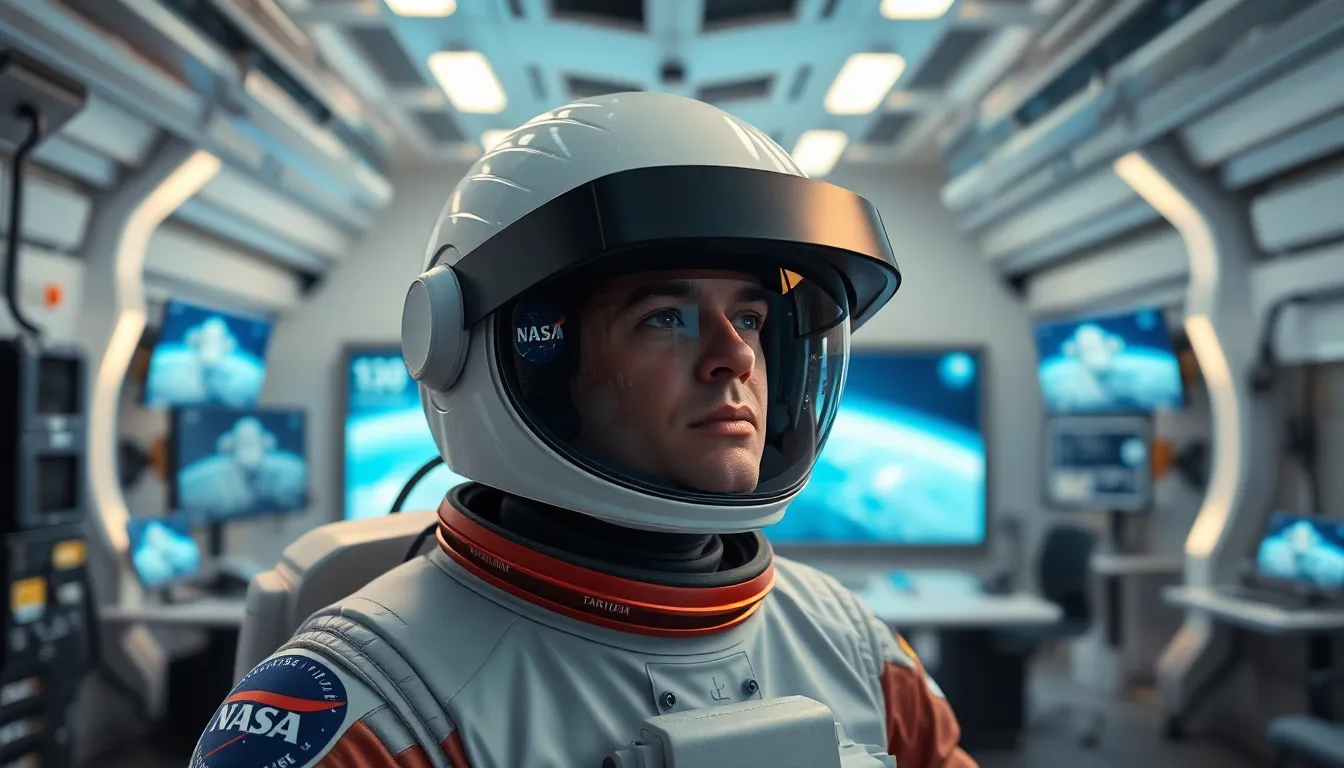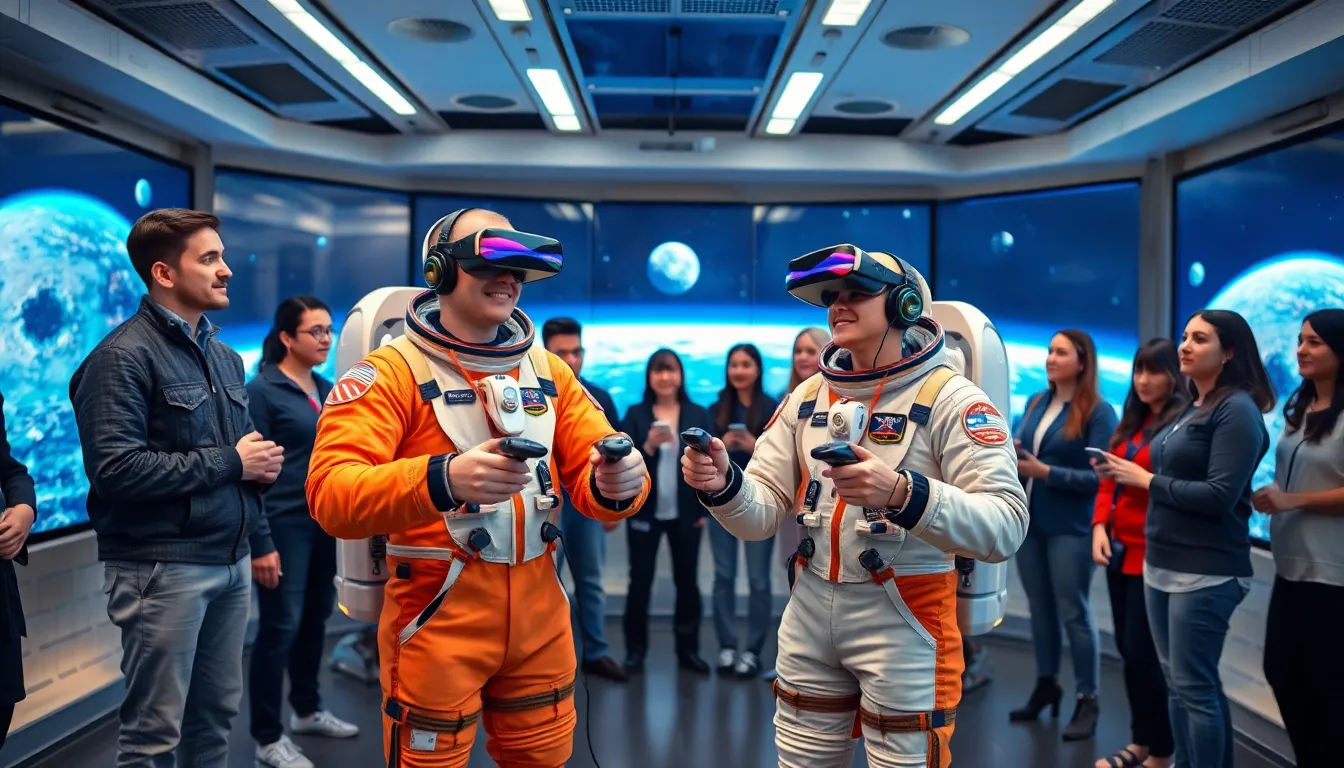Imagine strapping on a VR headset and blasting off into the cosmos without ever leaving your living room. Sounds like a sci-fi dream, right? Welcome to the world of VR space missions, where the final frontier is just a click away. These immersive experiences are revolutionizing how we explore the universe, making it accessible to everyone—from aspiring astronauts to couch potatoes.
Table of Contents
ToggleOverview of VR Space Missions
VR space missions utilize immersive technology to simulate space exploration. Users can navigate celestial bodies, experience zero gravity, and interact with virtual spacecraft. This technology transforms how individuals perceive space and its vast possibilities.
Various organizations develop VR space missions to enhance educational experiences. NASA offers programs like “Eyes on the Universe,” which allows users to explore astronomical phenomena in real time. Additionally, private companies focus on creating engaging VR applications that provide immersive training for future astronauts.
The data shows that students using VR tools demonstrate increased interest in STEM fields. Engagement levels rise significantly when learners experience virtual environments that replicate real-world science. VR can also simulate complex scenarios, allowing users to understand the intricacies of space missions effectively.
These experiences cater to diverse audiences. Casual users enjoy exploring the universe, while educators use VR missions to facilitate interactive lessons. Aspiring astronauts gain valuable insights into mission protocols and spacecraft operation through realistic training simulations.
Costs associated with VR space missions continue to decrease. Advancements in technology lead to more accessible systems, allowing broader adoption in schools and homes. As content expands, VR experiences covering new discoveries emerge frequently.
Overall, VR space missions create unique opportunities for exploration and education in the realm of space. They make the cosmos more tangible, bridging the gap between imagination and reality. The future holds potential for more innovative experiences, enhancing understanding of the universe’s wonders.
Historical Context

VR space missions emerged from a long history of technological innovations aimed at enhancing human experiences in exploration and education. Early developments in virtual reality set the groundwork for immersive space experiences that engage users worldwide.
Early Innovations in VR
Virtual reality technology traces back to the 1960s with pioneering devices like the Sensorama and the Sword of Damocles. These innovations laid the foundation for future advancements, significantly impacting how immersive environments developed. In the 1990s, companies introduced more sophisticated systems that began integrating graphics and interactive elements, allowing users to engage in simulated experiences. Research during this time indicated that VR could effectively enhance training methodologies. As a result, experiments focused on creating realistic simulations for various industries, including aerospace, began to flourish, showing promise for future applications in space missions.
Pioneering Space Missions
NASA led the charge in integrating VR into space exploration initiatives. Early applications included simulators for astronaut training, providing invaluable experience in complex mission environments. The “Virtual Reality Lab” at NASA became a cornerstone for testing technologies that created realistic scenarios for mission preparation. Collaborations with private companies further expanded these capabilities, resulting in educational programs designed to inspire the next generation of space enthusiasts. As these programs gained traction, they highlighted the potential of VR to broaden public engagement with space and contribute to STEM education. Current initiatives continue building on this legacy, showcasing amazing advancements in VR technology that enhance virtual space exploration experiences.
Technology Behind VR Space Missions
VR space missions rely on advanced technology that creates immersive cosmic experiences. This technology includes various hardware and software components designed for maximum engagement and realism.
VR Hardware Components
Essential components of VR hardware include headsets, motion controllers, and high-performance computers. Headsets like the Oculus Quest and HTC Vive offer high-resolution displays and wide fields of view to enhance immersion. Motion controllers enable users to interact seamlessly with virtual environments, simulating real-life movements. Powerful computers equipped with graphics processing units handle complex calculations for realistic visuals and smooth performance. Additionally, haptic feedback devices provide tactile sensations that replicate the experience of space missions, adding another layer of realism. Together, these components provide an interactive platform for users to explore simulations of space travel.
Software and Simulation Techniques
Software plays a crucial role in creating the virtual environments for space missions. Visualization programs simulate real celestial bodies and vehicles, utilizing high-resolution graphics to replicate authentic landscapes. Physics engines are employed to model zero-gravity environments, allowing users to experience weightlessness during their explorations. Additionally, AI-driven systems adapt scenarios based on user actions, making each mission unique and engaging. Data from real space missions informs these simulations, ensuring accuracy and enhancing educational value. This integration of software techniques fosters an engaging learning environment that bridges theoretical knowledge with practical experience in space exploration.
Applications of VR in Space Exploration
VR technologies enhance various aspects of space exploration, offering innovative solutions for training, education, and public engagement.
Mission Training and Preparation
Simulators create realistic training environments for astronauts. NASA employs VR to prepare astronauts for high-stress situations, providing immersive scenarios that mimic actual missions. Training programs incorporate tasks like spacecraft navigation and zero-gravity maneuvers. Participants experience challenges that prepare them for space’s unpredictability. This method saves resources by reducing the need for physical simulations and allows repeated practice without risk. Organizations can analyze performance metrics, making adjustments to improve trainee outcomes. Quantitative data shows that VR training significantly shortens preparation times and boosts confidence among astronauts, ensuring they’re ready for the complexities of space travel.
Public Engagement and Education
VR serves as a powerful tool for public engagement and education in space exploration. Interactive experiences allow users to explore the cosmos from home, inviting participation from diverse audiences. Programs like NASA’s “Eyes on the Universe” attract students and space enthusiasts alike, enhancing interest in science, technology, engineering, and mathematics (STEM). Research indicates that users who engage with these VR experiences demonstrate increased curiosity about space and its mysteries. Educators utilize VR to create dynamic lessons that captivate students, making complex concepts accessible and enticing. Collaborative projects with educational institutions facilitate access to VR technology, ensuring more comprehensive outreach and inspirational learning experiences in astronomy and space science.
Future Trends in VR Space Missions
The future of VR space missions shows great promise, driven by continuous advancements in technology and its potential to impact space travel.
Advancements in Technology
Innovative hardware continues to enhance user experiences. High-resolution displays and lightweight headsets improve comfort and visual fidelity. Improved motion tracking allows users to navigate more naturally, while haptic feedback devices deepen the sense of immersion. Enhanced software implements realistic simulations of space environments and celestial bodies. AI technologies integrate adaptive learning into missions, allowing unique exploration experiences tailored to user preferences. Data from ongoing developments indicates rapid progress in graphics quality, which elevates the realism of VR experiences. The combination of these technologies not only revolutionizes education but also supports enthusiastic engagement in space exploration.
Potential Impact on Space Travel
VR technologies may transform future space missions significantly. Trainings using realistic simulations ensure astronauts feel prepared for real-life scenarios, which may increase mission safety. Furthermore, virtual environments could facilitate public engagement, sparking interest in space travel among a broader audience. As VR applications grow, the prospect of training potential astronauts through immersive experiences becomes increasingly viable. Long-distance space travel simulations might help scientists understand the psychological effects on crew members, thus improving mission designs. Organizations like NASA envision these advanced training tools as critical components in preparing for missions beyond Earth, bridging the gap between training and actual space exploration.
VR space missions are reshaping how individuals engage with the cosmos. By making space exploration accessible and immersive, these experiences inspire curiosity and foster a deeper understanding of the universe. As technology continues to advance, the potential for more realistic and interactive simulations grows, paving the way for innovative educational tools and training methodologies.
Organizations like NASA are at the forefront of this evolution, integrating VR into astronaut training and public outreach. The future holds exciting possibilities for VR applications in space exploration, enhancing both learning and engagement. As more people experience the wonders of the universe through VR, the dream of space travel becomes more tangible for everyone.




